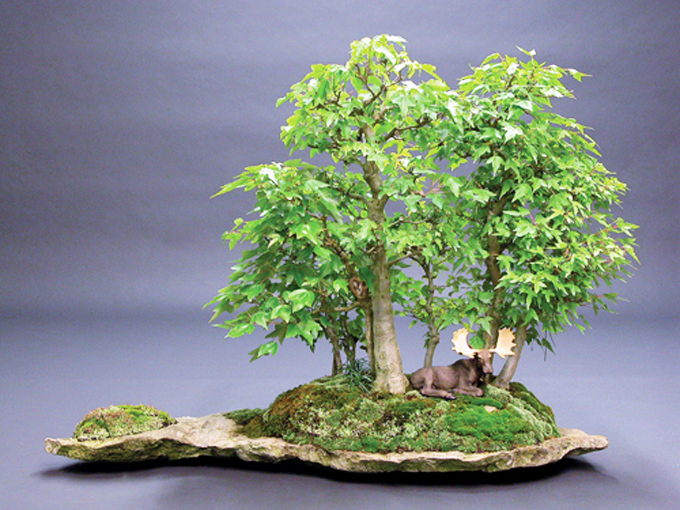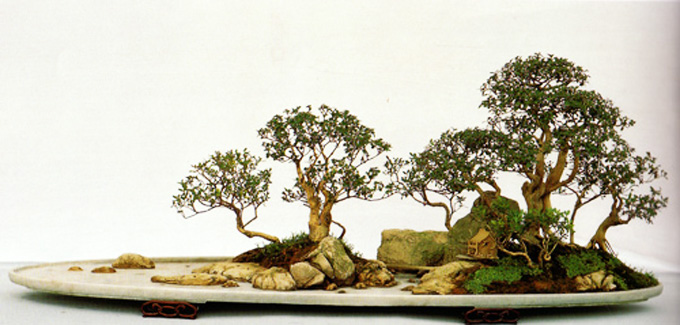 Using figurines in tray plantings doesn’t necessarily qualify as eccentric; it’s common in Chinese (and other) penjing plantings. Perhaps it’s the type (you don’t see many moose in China) and especially the relative size of the figurine that makes this trident maple planting unusual. This photo is from an article by Randy Clark entitled ‘Bonsai & Figurines’ that originally appeared in Bonsai Today issue 95. Randy Clark is the owner of the Bonsai Learning Center (note: that was 2009, Randy has moved on since then).
Using figurines in tray plantings doesn’t necessarily qualify as eccentric; it’s common in Chinese (and other) penjing plantings. Perhaps it’s the type (you don’t see many moose in China) and especially the relative size of the figurine that makes this trident maple planting unusual. This photo is from an article by Randy Clark entitled ‘Bonsai & Figurines’ that originally appeared in Bonsai Today issue 95. Randy Clark is the owner of the Bonsai Learning Center (note: that was 2009, Randy has moved on since then).
We’re digging way back into the recesses of time for this one. It was originally called In Whose Eye? Eccentric Bonsai #2: Figurines, but that was long ago (2009) when attention spans were much longer. Now, in keeping with the times, we’ll go with something shorter and with a little more punch. And once again, don’t fret, soon we’ll return to fresh never-seen-before posts. Meanwhile…
The Japanese seldom use them…
…. but the Chinese (and some others) often do. When it comes to figurines, basically its: penjing ‘yes’, Japanese bonsai ‘no,’ (the exception is very small figures used in some Japanese saikei) and Randy Clark’s ‘why not explore the issue?’ Most people I know are somewhere past ‘why not’ and leaning towards ‘just say no.’
Indiscriminate use
If you are like most serious Western bonsai enthusiasts, you usually avoid figurines. This is probably due to the fact that Japanese bonsai has enjoyed an earlier and stronger influence in the West than Chinese penjing. And the rampant and indiscriminate use of poorly made figurines in cheap (but overpriced) commercial bonsai hasn’t helped. Besides, when it comes to quality bonsai, ‘why gild the lily?’ might be a question worth asking (note from now: this isn’t to say you shouldn’t do what you want, conventions and opinion be damned… but still…).
 This penjing by Quinquan Zhao. It’s from his benchmark book, Penjing: Worlds of Wonderment. The little hut that almost disappears into the landscape is the only figurine (?) I can see. This unobtrusive blending is a way to create a sense of scale. When you notice the hut, suddenly the whole arrangement becomes much larger (another note from the present; Worlds of Wonderment is out of print, but fortunately, Mr Zhao has a newer penjing book, Penjing, The Chinese Art of Bonsai).
This penjing by Quinquan Zhao. It’s from his benchmark book, Penjing: Worlds of Wonderment. The little hut that almost disappears into the landscape is the only figurine (?) I can see. This unobtrusive blending is a way to create a sense of scale. When you notice the hut, suddenly the whole arrangement becomes much larger (another note from the present; Worlds of Wonderment is out of print, but fortunately, Mr Zhao has a newer penjing book, Penjing, The Chinese Art of Bonsai).

Another of Randy Clark’s plantings (from Bonsai Today issue 95). The bear is proportionally much larger than the humans, animals and other man made elements in most penjing plantings. So much larger, that it becomes the focal point of the composition.
I love to see figures in plantings if they are not cheap, in proportion & natural! It gives the planting a more real feel.
Yes the bear is way too big for the planting but in a strange way it makes what is a very ordinary (boring?) landscape more interesting to look at, although I can’t for the life of me work out why.
Wayne… I am honored to see my humble creations appearing in Bonsai Bark. For that… many thanks. When it comes to the use of figurines in bonsai, please consider this: It does not matter what the size of the figurine used in a planting is. What matters is: Does the use of this figurine contribute or detract from the visual and emotional impact on the viewer? i.e. – Is what the artist has assembled helping to create an intellectual or more importantly an emotional involvement with what he or she is viewing? The dedicated bonsai artist would be well advised to learn both the Japanese and Chinese rules regarding creation of a proper bonsai… and the discard most of them. Only then will Western artists begin to make new inroads into what has heretofore been an Asian art.
You are welcome Randy and thanks for sending those photos from the 7th WBFF Convention in China. Look for some of them here soon.